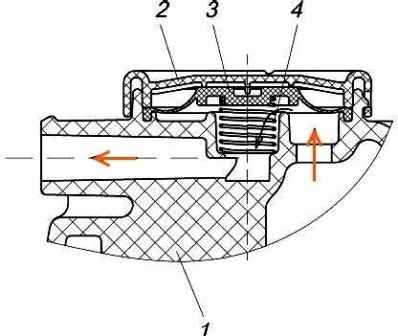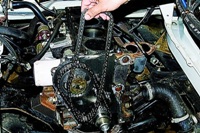The intake system consists of an intake pipe and a receiver, cast from aluminum alloy
The geometric parameters of the system make it possible to implement gas-dynamic supercharging of the engine - improving the filling of the engine cylinders in a certain mode of its operation
The receiver has additional attachments to the cylinder head to increase rigidity and reduce vibrations.
To control the air supply to the engine, a throttle module with an electric throttle actuator and a throttle position sensor controlled from the control unit is used.
The throttle position is determined by the current engine operating mode and the position of the accelerator pedal.
At idle, air is supplied to the engine cylinders, as in all other modes - through the throttle, receiver and intake pipe.
In this regard, there is no idle air passage in the intake pipe.

The exhaust manifold is cast from ductile iron. To improve the cleaning of engine cylinders from exhaust gases, pipes from 1 and 4, 2 and 3 cylinders are interconnected.
This reduces the influence of the operation of one cylinder on the other and allows you to realize the effect of a tuned exhaust gas.
The flanges of the manifold for connecting to the cylinder head are interconnected by ribs, which increases the rigidity of the structure.
The exhaust manifold is attached to the cylinder head through a two-layer steel gasket, which ensures high reliability of the connection.
The collector is covered with a steel stamped screen to reduce the thermal impact on the surrounding parts of the engine compartment of the car.
Crankcase ventilation system
The crankcase ventilation system is closed, forced, acting due to the vacuum in the intake system created during engine operation.
The system is equipped with a pressure reducing valve (vacuum valve) that maintains a constant vacuum in the engine crankcase.

The valve cover pipe is connected to the air intake system.
Under the influence of vacuum in the intake system, gases that have broken through during the combustion of fuel into the engine crankcase enter the cylinder head with oil mist and then into the cavity formed by the valve cover and oil deflector 5.
Passing through the labyrinth formed by the partitions of the oil deflector and the valve covers, oil vapors are separated from the crankcase gases, and the drained crankcase gases enter through the rarefaction valve 4 into the air intake system and into the engine cylinders, where they are burned.
The oil separated in the oil separator accumulates in the grooves of the oil deflector, from where it drains through the holes in the tubes 6 into the cylinder head.
Suction of crankcase gases from the valve cover when the engine is running at idle and partial loads is carried out through a small branch of ventilation 2 to the receiver 1, in other modes - along the main branch of ventilation of the crankcase 3 to the intake system in the area between the air filter and the throttle.
It is forbidden to operate the engine with a leaky ventilation system and an open oil filler pipe.
This will cause increased oil carryover with crankcase gases and environmental pollution.
Vacuum valve - serves to maintain the vacuum in the crankcase at a constant level in all modes of its operation and thereby increases the reliability of the crankshaft stuffing box seals.
The vacuum valve is installed in the valve cover
Thanks to the vacuum valve, a vacuum of 40 - 50 mm of water is constantly maintained in the crankcase. (400 - 500 Pa).
The valve consists of a rubber diaphragm 3 and a spring 4, closed by a cover 2.
Depending on the vacuum in the intake system, diaphragm 3, overcoming the force of spring 4, changes its position and thereby increases or decreases the cross section of the air channel that communicates the valve cover with the intake system.
If there is a strong vacuum in the intake system (for example, with an excessively dirty air filter), the valve diaphragm completely blocks the crankcase exhaust channel.
Maintenance crankcase ventilation system
Care of the crankcase ventilation system consists in periodic flushing and cleaning of channels and hoses.
The operation of the crankcase ventilation system can be checked as follows:
- - when the engine is running at the minimum crankshaft speed in idle mode, there should be a vacuum in the engine crankcase, but not more than 50 mm of water. (500 Pa).
This is determined using a water piezometer connected to the engine crankcase through an oil gauge tube.
- - pressure of crankcase gases is possible due to coking of the channels of the ventilation system or sticking of the diaphragm of the rarefaction valve and complete blocking of the channel for suction of crankcase gases or increased breakthrough of gases into the engine crankcase.
When the vacuum in the engine crankcase is more than 50 mm of water column. (500 Pa) check the condition of the underpressure valve parts. Replace damaged diaphragm.
With increased oil consumption for waste, attention should be paid to the tightness of the oil deflector and the clogging of the holes in the oil drain tubes of the oil deflector
Leakage of the oil deflector or its installation will lead to the passage of part of the crankcase gases with oil mist bypassing the labyrinth of the oil separator, incomplete separation of oil, its suction with crankcase gases into the engine cylinders and waste
The defect should be eliminated by installing the oil deflector on the sealant or replacing it.
After every 40,000 km of run or in case of crankcase gas pressure, the parts of the ventilation system should be cleaned:
1. Remove ventilation hoses with ventilation tube and valve cover. Remove the oil deflector from the valve cover, remove the vacuum valve cover, remove the diaphragm and spring.
Inspect the removed parts.
Ruptures and damage to the diaphragm, damage to parts that lead to a breach of tightness, should be absent.
2. Clean the valve cover channels, oil deflector, oil deflector drain pipes, vacuum valve diaphragm and spring, passages in hoses and ventilation tube from tarry deposits and carbon deposits by washing in gasoline or kerosene.
When washing, do not use solvents that corrode plastic and rubber parts.
3. Wipe the parts dry with a rag or blow with compressed air, assemble the valve cover and install the removed parts on the engine.
When assembling, ensure the tightness of the joints.











